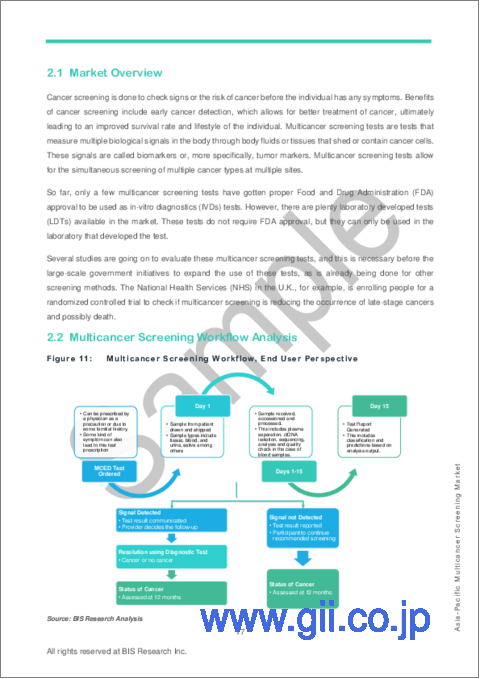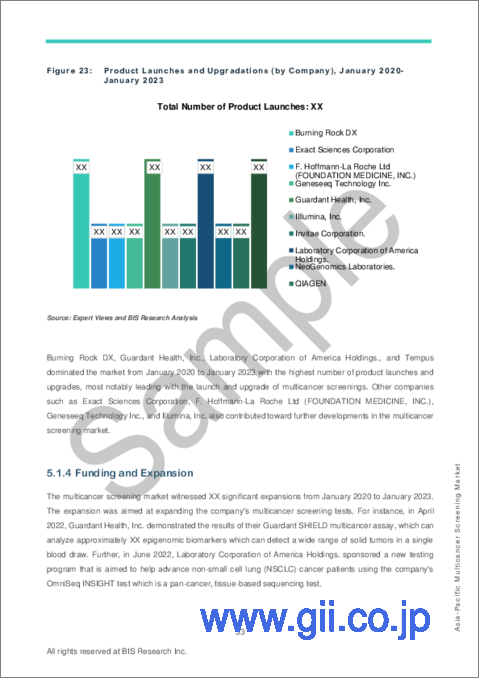|
|
市場調査レポート
商品コード
1385468
アジア太平洋の2D材料市場 - 分析と予測(2022年~2031年)Asia-Pacific 2D Materials Market - Analysis and Forecast, 2022-2031 |
||||||
カスタマイズ可能
|
|||||||
| アジア太平洋の2D材料市場 - 分析と予測(2022年~2031年) |
|
出版日: 2023年11月24日
発行: BIS Research
ページ情報: 英文 121 Pages
納期: 1~5営業日
|
全表示
- 概要
- 図表
- 目次
アジア太平洋の2D材料の市場規模(中国を除く)は、2022年の9,520万米ドルから2031年には7億5,600万米ドルに達し、予測期間の2022年~2031年のCAGRは25.9%でになると予測されています。
エネルギー貯蔵デバイス、エレクトロニクス、半導体、複合材料・コーティング、医薬品、自動車などの最終用途分野からのニーズの高まりとともに、2D材料市場は拡大すると予測されています。さらに、2D材料の世界市場は、2022年~2031年の予測期間を通じて成長を続けると予測されており、その主な要因は、ヘルスケア分野における2D材料の使用拡大と、Mxene、TMDC、六方晶窒化ホウ素などの非グラフェン2D材料の使用拡大です。しかし、近い将来、生産コストの高さが市場拡大の妨げになると予測されています。
| 主要市場統計 | |
|---|---|
| 予測期間 | 2022年~2031年 |
| 2022年評価 | 9,520万米ドル |
| 2031年予測 | 7億5,600万米ドル |
| CAGR | 25.9% |
アジア太平洋(アジア太平洋)の二次元材料産業が拡大しています。同地域の燃料電池自動車市場は、燃料電池の普及率上昇に加え、公害防止や脱炭素化への関心の高まりから成長が見込まれています。さらに、エンドユーザー産業からの旺盛な需要や、エレクトロニクス産業における透明導電性フィルム(TCF)への要求の拡大が、アジア太平洋市場の需要増につながる可能性が高いです。アジア太平洋におけるナノ材料市場の成長により、2D材料市場は成長を続けると予想されます。興味深いことに、同地域ではスポーツ用品や太陽光発電への応用が2D材料の需要を牽引しています。
当レポートでは、アジア太平洋の2D材料市場について調査し、市場の概要とともに、エンドユーザー別、材料タイプ別、国別の動向、および市場に参入する企業のプロファイルなどを提供しています。
目次
第1章 市場
- 業界の見通し
- ビジネスダイナミクス
- スタートアップの情勢
第2章 地域
- 中国
- アジア太平洋と日本
第3章 市場-競合ベンチマーキングと企業プロファイル
- 競合ベンチマーキング
- 競争力マトリックス
- 主要企業の材料タイプ別の製品マトリックス
- 主要企業の市場シェア分析、2021年
- 企業プロファイル
- 6Carbon Technology
- Nitronix Nanotechnology Corporation
- 2D Water
第4章 調査手法
List of Figures
- Figure 1: Asia-Pacific 2D Materials Market, $Million, 2021, 2022, and 2031
- Figure 2: Asia-Pacific 2D Materials Market (by End User), $Million, 2021 and 2031
- Figure 3: Asia-Pacific 2D Materials Market (by Material Type), $Million, 2021 and 2031
- Figure 4: 2D Materials Market (by Region), $Million, 2021 and 2031
- Figure 5: Asia-Pacific Fuel Cell Electric Vehicle Fleets
- Figure 6: Advantages of Employing Graphene in Fuel Cells
- Figure 7: Advantages of Graphene and Derivatives in Fuel Cell Applications
- Figure 8: Importance of Graphene in Achieving Sustainability Goals
- Figure 9: Different Types of 2D Materials as Efficient ECR Electrocatalysts
- Figure 10: Supply Chain Analysis of the 2D Materials Market
- Figure 11: Automotive Production, Units, 2019-2021
- Figure 12: Billing of Semiconductor Industry, $Billion, 2018-2022
- Figure 13: Renewable Energy Capacity Additions (by Region), 2019-2021
- Figure 14: Difference Between Bulk Materials and Nano Materials
- Figure 15: Comparison Analysis Between Graphene and TMDCs
- Figure 16: Different Methodologies of 2D Materials
- Figure 17: Different Applications of Graphene/Mxene Composite in Medical Field
- Figure 18: Smart Nanomaterials Market Snapshot
- Figure 19: Clean Energy Investment in the Net Zero Pathway, $Trillion, 2016-2050
- Figure 20: Numerous Types of Applications for Graphene Conductive Films
- Figure 21: Numerous Types of Non-Graphene Materials and their Usage in Different Applications
- Figure 22: Research Methodology
- Figure 23: Top-Down and Bottom-Up Approach
- Figure 24: 2D Materials Market: Influencing Factors
- Figure 25: Assumptions and Limitations
List of Tables
- Table 1: Consortiums and Associations
- Table 2: Regulatory/Certification Bodies
- Table 3: List of Government Programs for 2D Materials Market
- Table 4: List of Programs by Research Institutions and Universities
- Table 5: Key Product Developments
- Table 6: Key Market Developments
- Table 7: Key Mergers and Acquisitions
- Table 8: Key Partnerships and Joint Ventures
- Table 9: 2D Materials Market (by Region), Tons, 2021-2031
- Table 10: 2D Materials Market (by Region), $Million, 2021-2031
- Table 11: China 2D Materials Market (by End User), Tons, 2021-2031
- Table 12: China 2D Materials Market (by End User), $Million, 2021-2031
- Table 13: China 2D Materials Market (by Material Type), Tons, 2021-2031
- Table 14: China 2D Materials Market (by Material Type), $Million, 2021-2031
- Table 15: Asia-Pacific and Japan 2D Materials Market (by End User), Tons, 2021-2031
- Table 16: Asia-Pacific and Japan 2D Materials Market (by End User), $Million, 2021-2031
- Table 17: Asia-Pacific and Japan 2D Materials Market (by Material Type), Tons, 2021-2031
- Table 18: Asia-Pacific and Japan 2D Materials Market (by Material Type), $Million, 2021-2031
- Table 19: Japan 2D Materials Market (by End User), Tons, 2021-2031
- Table 20: Japan 2D Materials Market (by End User), $Million, 2021-2031
- Table 21: Japan 2D Materials Market (by Material Type), Tons, 2021-2031
- Table 22: Japan 2D Materials Market (by Material Type), $Million, 2021-2031
- Table 23: South Korea 2D Materials Market (by End User), Tons, 2021-2031
- Table 24: South Korea 2D Materials Market (by End User), $Million, 2021-2031
- Table 25: South Korea 2D Materials Market (by Material Type), Tons, 2021-2031
- Table 26: South Korea 2D Materials Market (by Material Type), $Million, 2021-2031
- Table 27: India 2D Materials Market (by End User), Tons, 2021-2031
- Table 28: India 2D Materials Market (by End User), $Million, 2021-2031
- Table 29: India 2D Materials Market (by Material Type), Tons, 2021-2031
- Table 30: India 2D Materials Market (by Material Type), $Million, 2021-2031
- Table 31: Australia 2D Materials Market (by End User), Tons, 2021-2031
- Table 32: Australia 2D Materials Market (by End User), $Million, 2021-2031
- Table 33: Australia 2D Materials Market (by Material Type), Tons, 2021-2031
- Table 34: Australia 2D Materials Market (by Material Type), $Million, 2021-2031
- Table 35: Rest-of-Asia-Pacific and Japan 2D Materials Market (by End User), Tons, 2021-2031
- Table 36: Rest-of-Asia-Pacific and Japan 2D Materials Market (by End User), $Million, 2021-2031
- Table 37: Rest-of-Asia-Pacific and Japan 2D Materials Market (by Material Type), Tons, 2021-2031
- Table 38: Rest-of-Asia-Pacific and Japan 2D Materials Market (by Material Type), $Million, 2021-2031
- Table 39: Product Matrix for Key Companies, By Material Type
- Table 40: Market Shares of Key Companies, 2021
“The Asia-Pacific 2D Materials Market (excluding China) Expected to Reach $756.0 Million by 2031.”
Introduction to Asia-Pacific (APAC) 2D Materials Market
The Asia-Pacific 2D materials market (excluding China) is projected to reach $756.0 million by 2031 from $95.2 million in 2022, growing at a CAGR of 25.9% during the forecast period 2022-2031. Along with the growing need from end-use sectors including energy storage devices, electronics, semiconductors, composite and coatings, pharmaceuticals, automotive, and others, it is projected that the market for 2D materials would expand. Additionally, it is predicted that the global market for 2D materials will continue to grow throughout the projected period of 2022-2031, driven primarily by the growing use of 2D materials in the healthcare sector and the growing use of non-graphene 2D materials like Mxene, TMDCs, hexagonal boron nitride, and others. However, it is projected that in the near future, the high cost of production would impede market expansion.
| KEY MARKET STATISTICS | |
|---|---|
| Forecast Period | 2022 - 2031 |
| 2022 Evaluation | $95.2 Million |
| 2031 Forecast | $756.0 Million |
| CAGR | 25.9% |
Market Introduction
The 2D materials industry in Asia-Pacific (APAC) is expanding. The region's fuel cell vehicle market is expected to grow as a result of rising fuel cell adoption rates as well as increased focus on pollution prevention and decarbonization. Furthermore, the strong demands from end-user industries and the expanding requirement for transparent conductive films (TCF) in the electronics industry would likely lead to increased demand in the APAC market. The market for 2D materials is anticipated to continue growing as a result of the growing nanomaterials market in Asia-Pacific. Interestingly, applications in sports equipment and photovoltaics in the area are driving demand for 2D materials.
Market Segmentation:
Segmentation 1: by End User
- Composite and Coatings
- Energy Storage Devices
- Electronics
- Semiconductor
- Pharmaceuticals
- Automobiles
- Others
Segmentation 2: by Material Type
- Graphene
- Black Phosphorous
- Transition Metal Dichalcogenides
- Mxene
- Hexagonal boron nitride
- Others
Segmentation 3: by Country
- Japan
- India
- South Korea
- Australia
- Rest-of-Asia-Pacific and Japan
How can this report add value to an organization?
Product/Innovation Strategy: The product segment helps the reader to understand the different material types involved in 2D materials. Moreover, the study provides the reader with a detailed understanding of the Asia-Pacific 2D materials market based on the end user (composite and coatings, energy storage devices, electronics, semiconductors, pharmaceuticals, automobiles, and others). 2D materials are gaining traction in end-user industries on the back of sustainability concerns and their high durability properties. They are also being used for controlling greenhouse gas (GHG) emissions.
Growth/Marketing Strategy: The Asia-Pacific 2D materials market has seen major development by key players operating in the market, such as business expansions, partnerships, collaborations, mergers and acquisitions, and joint ventures. The favored strategy for the companies has been product developments, business expansions, and acquisitions to strengthen their position in the Asia-Pacific 2D materials market.
Competitive Strategy: Key players in the Asia-Pacific 2D materials market analyzed and profiled in the study involve 2D materials manufacturers and the overall ecosystem. Moreover, a detailed competitive benchmarking of the players operating in the Asia-Pacific 2D materials market has been done to help the reader understand how players stack against each other, presenting a clear market landscape. Additionally, comprehensive competitive strategies such as partnerships, agreements, acquisitions, and collaborations will aid the reader in understanding the untapped revenue pockets in the market.
Key Market Players and Competition Synopsis
The companies that are profiled have been selected based on inputs gathered from primary experts, analyzing company coverage, product portfolio, and market penetration.
Some of the prominent established names in this market are:
|
|
Table of Contents
1 Markets
- 1.1 Industry Outlook
- 1.1.1 Trends: Current and Future
- 1.1.1.1 Increasing Demand of 2D Materials for Hydrogen Fuel Cells in Electric Vehicles
- 1.1.1.2 Increasing Preference of 2D Materials to Lessen the Pollutants
- 1.1.2 Supply Chain Analysis
- 1.1.3 Ecosystem of 2D Materials Market
- 1.1.3.1 Consortiums and Associations
- 1.1.3.2 Regulatory/Certification Bodies
- 1.1.3.3 Government Programs
- 1.1.3.4 Programs by Research Institutions and Universities
- 1.1.4 Impact of COVID-19 on 2D Materials Market
- 1.1.4.1 Impact of COVID-19 on Automotive Industry
- 1.1.4.2 Impact of COVID-19 on Semiconductor Industry
- 1.1.4.3 Impact of COVID-19 on Energy Storage Devices
- 1.1.4.4 Impact of COVID-19 on Health Care Industry
- 1.1.5 Impact of Semiconductor Crisis on 2D Materials Market
- 1.1.6 Comparative Analysis Between Bulk Materials and Nano Materials
- 1.1.7 Comparative Analysis Between Transition Metal Dichalcogenides (TMDCs) and Graphene
- 1.1.8 Methodologies of 2D Materials
- 1.1.9 Significant Advancements in Graphene and Other 2D Materials
- 1.1.10 Emergence of Hybrid Technology
- 1.1.11 Recent Investments Made in 2D Materials
- 1.1.12 Emerging Start-Up Companies of 2D Materials
- 1.1.13 Snapshot of Smart Nanomaterials Market
- 1.1.1 Trends: Current and Future
- 1.2 Business Dynamics
- 1.2.1 Business Drivers
- 1.2.1.1 Growing Adoption of 2D materials in Energy Storage
- 1.2.1.2 Strong Growth of 2D Materials in the Healthcare Industry
- 1.2.1.3 Growing Demand of Transparent Conductive Films (TCF) in Electronic Industry
- 1.2.2 Business Challenges
- 1.2.2.1 Lack of Large-Scale Production of High-Quality Graphene
- 1.2.2.2 High Cost of Production
- 1.2.3 Business Strategies
- 1.2.3.1 Product Developments
- 1.2.3.2 Market Developments
- 1.2.4 Corporate Strategies
- 1.2.4.1 Mergers and Acquisitions
- 1.2.4.2 Partnerships and Joint Ventures
- 1.2.5 Business Opportunities
- 1.2.5.1 Expanding Market of Nanomaterials for Easily accessible Electric Vehicles
- 1.2.5.2 Increasing Opportunities for Non-Graphene 2D Materials
- 1.2.1 Business Drivers
- 1.3 Start-Up Landscape
- 1.3.1 Key Start-Ups in the Ecosystem
2 Regions
- 2.1 China
- 2.1.1 Market
- 2.1.1.1 Buyer Attributes
- 2.1.1.2 Key Producers and Suppliers in China
- 2.1.1.3 Regulatory Landscape
- 2.1.1.4 Business Drivers
- 2.1.1.5 Business Challenges
- 2.1.2 Applications
- 2.1.2.1 China 2D Materials Market (by End User), Volume and Value Data
- 2.1.3 Products
- 2.1.3.1 China 2D Materials Market (by Material Type), Volume and Value Data
- 2.1.1 Market
- 2.2 Asia-Pacific and Japan
- 2.2.1 Market
- 2.2.1.1 Key Producers and Suppliers in Asia-Pacific and Japan
- 2.2.1.2 Business Drivers
- 2.2.1.3 Business Challenges
- 2.2.2 Applications
- 2.2.2.1 Asia-Pacific and Japan 2D Materials Market (by End User), Volume and Value Data
- 2.2.3 Products
- 2.2.3.1 Asia-Pacific and Japan 2D Materials Market (by Material Type), Volume and Value Data
- 2.2.4 Asia-Pacific and Japan (by Country)
- 2.2.4.1 Japan
- 2.2.4.1.1 Market
- 2.2.4.1.1.1 Buyer Attributes
- 2.2.4.1.1.2 Key Producers and Suppliers in Japan
- 2.2.4.1.1.3 Regulatory Landscape
- 2.2.4.1.1.4 Business Drivers
- 2.2.4.1.1.5 Business Challenges
- 2.2.4.1.2 Applications
- 2.2.4.1.2.1 Japan 2D Materials Market (by End User), Volume and Value Data
- 2.2.4.1.3 Products
- 2.2.4.1.3.1 Japan 2D Materials Market (by Material Type), Volume and Value Data
- 2.2.4.1.1 Market
- 2.2.4.2 South Korea
- 2.2.4.2.1 Market
- 2.2.4.2.1.1 Buyer Attributes
- 2.2.4.2.1.2 Key Producers and Suppliers in South Korea
- 2.2.4.2.1.3 Regulatory Landscape
- 2.2.4.2.1.4 Business Drivers
- 2.2.4.2.1.5 Business Challenges
- 2.2.4.2.2 Applications
- 2.2.4.2.2.1 South Korea 2D Materials Market (by End User), Volume and Value Data
- 2.2.4.2.3 Products
- 2.2.4.2.3.1 South Korea 2D Materials Market (by Material Type), Volume and Value Data
- 2.2.4.2.1 Market
- 2.2.4.3 India
- 2.2.4.3.1 Market
- 2.2.4.3.1.1 Buyer Attributes
- 2.2.4.3.1.2 Key Producers and Suppliers in India
- 2.2.4.3.1.3 Regulatory Landscape
- 2.2.4.3.1.4 Business Drivers
- 2.2.4.3.1.5 Business Challenges
- 2.2.4.3.2 Applications
- 2.2.4.3.2.1 India 2D Materials Market (by End User), Volume and Value Data
- 2.2.4.3.3 Products
- 2.2.4.3.3.1 India 2D Materials Market (by Material Type), Volume and Value Data
- 2.2.4.3.1 Market
- 2.2.4.4 Australia
- 2.2.4.4.1 Market
- 2.2.4.4.1.1 Buyer Attributes
- 2.2.4.4.1.2 Key Producers and Suppliers in Australia
- 2.2.4.4.1.3 Regulatory Landscape
- 2.2.4.4.1.4 Business Drivers
- 2.2.4.4.1.5 Business Challenges
- 2.2.4.4.2 Applications
- 2.2.4.4.2.1 Australia 2D Materials Market (by End User), Volume and Value Data
- 2.2.4.4.3 Products
- 2.2.4.4.3.1 Australia 2D Materials Market (by Material Type), Volume and Value Data
- 2.2.4.4.1 Market
- 2.2.4.5 Rest-of-Asia-Pacific and Japan
- 2.2.4.5.1 Market
- 2.2.4.5.1.1 Buyer Attributes
- 2.2.4.5.1.2 Key Producers and Suppliers in Rest-of-Asia-Pacific and Japan
- 2.2.4.5.1.3 Business Drivers
- 2.2.4.5.1.4 Business Challenges
- 2.2.4.5.2 Applications
- 2.2.4.5.2.1 Rest-of-Asia-Pacific and Japan 2D Materials Market (by End User), Volume and Value Data
- 2.2.4.5.3 Products
- 2.2.4.5.3.1 Rest-of-Asia-Pacific and Japan 2D Materials Market (by Material Type), Volume and Value Data
- 2.2.4.5.1 Market
- 2.2.4.1 Japan
- 2.2.1 Market
3 Markets - Competitive Benchmarking & Company Profiles
- 3.1 Competitive Benchmarking
- 3.1.1 Competitive Position Matrix
- 3.1.2 Product Matrix for Key Companies, By Material Type
- 3.1.3 Market Share Analysis of Key Companies, 2021
- 3.2 Company Profiles
- 3.2.1 6Carbon Technology
- 3.2.1.1 Company Overview
- 3.2.1.1.1 Role of 6Carbon Technology in the Asia-Pacific 2D Materials Market
- 3.2.1.1.2 Product Portfolio
- 3.2.1.1.3 Production Sites
- 3.2.1.2 Analyst View
- 3.2.1.1 Company Overview
- 3.2.2 Nitronix Nanotechnology Corporation
- 3.2.2.1 Company Overview
- 3.2.2.1.1 Role of Nitronix Nanotechnology Corporation in the Asia-Pacific 2D Materials Market
- 3.2.2.1.2 Product Portfolio
- 3.2.2.1.3 Production Sites
- 3.2.2.2 Corporate Strategies
- 3.2.2.2.1 Partnerships, Collaborations, and Joint Ventures
- 3.2.2.3 Analyst View
- 3.2.2.1 Company Overview
- 3.2.3 2D Water
- 3.2.3.1 Company Overview
- 3.2.3.1.1 Role of 2D Water in the Asia-Pacific 2D Materials Market
- 3.2.3.1.2 Product Portfolio
- 3.2.3.1.3 Production Sites
- 3.2.3.2 Analyst View
- 3.2.3.1 Company Overview
- 3.2.1 6Carbon Technology
4 Research Methodology
- 4.1 Primary Data Sources
- 4.2 BIS Data Sources
- 4.3 Assumptions and Limitations






